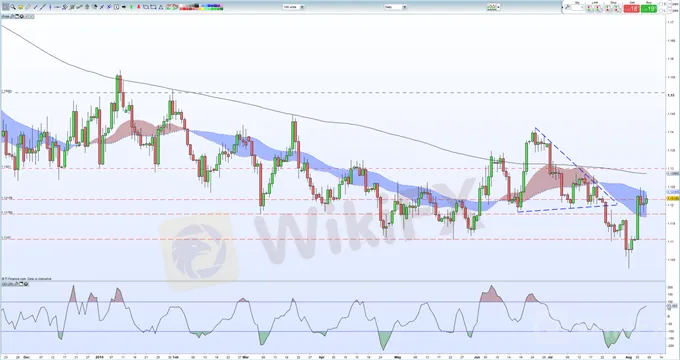简体中文
繁體中文
English
Pусский
日本語
ภาษาไทย
Tiếng Việt
Bahasa Indonesia
Español
हिन्दी
Filippiiniläinen
Français
Deutsch
Português
Türkçe
한국어
العربية
EUR/USD Price Outlook Muted, ECB Bulletin Points to Global Uncertainties
Abstract:Softening global growth and weak international trade are weighing on the euro area outlook, according to the latest ECB Bulletin, leaving EURUSD under downside pressure.
ECB Bulletin and EURUSD Price, Chart and Analysis:
Realise and projected inflation persistently below ECBs aim.
Further EURUSD upside likely limited unless the US dollar breaks lower.
Q3 2019 EUR and USD Forecasts andTop Trading Opportunities
Keep up to date with all key economic data and event releases via the DailyFX Economic Calendar
The latest ECB Economic Bulletin underscores the current weakness in the manufacturing sector and says that the drop in the global services output Purchasing Managers' Index in June “raises the risk of a more broad-based deterioration in the global growth outlook.” The release also reiterated the need for a “highly accommodative stance of monetary policy for a prolonged period of time, as inflation rates, both realised and projected, have been persistently below levels that are in line with its aim.” Financial markets are now fully pricing-in a 10 basis point cut in the deposit rate to -0.50% from a current 0.40% at the September ECB meeting with growing expectations that the ECB will also announce details of a new round of quantitative easing. Eurozone bond markets continue to rally, pushing yields further into negative territory, ahead of this announcement and will likely extend the move in the coming months, weakening the single currency.
EURUSD Price Remains Fragile After German Industrial Production Slump
EURUSD continues to trade either side of 1.1200 and is likely to remain stuck around these levels as currency wars continue. Appreciation in the Euro is likely to be muted and EURUSD traders will be looking ahead to the next ECB rate decision (September 12) and the FOMC meeting (September 18). The ECB is expected to cut by 10bps while the Fed is expected to cut by 25 basis points with a 50 basis point cut seen as unlikely but still a possibility. The interest rate differential between the two central banks after these meetings will help drive, or reinforce, the next move in EURUSD. Until then EURUSD will likely trade sideways without any conviction.
EURUSD Daily Price Chart (December 2018 – August 8, 2019)

IG Client Sentiment data shows traders are 52.8% net-long EURUSD, a bearish contrarian bias. However, the number of traders net-long is 11.3% lower than yesterday and 41.5% lower from last week, while the number of traders net-short is 2.2% higher than yesterday and 50.4% higher from last week. See how these recent positional changes move EURUSD trading sentiment.
Traders may be interested in two of our trading guides – Traits of Successful Traders and Top Trading Lessons – while technical analysts are likely to be interested in our latest Elliott Wave Guide.
What is your view on EURUSD – bullish or bearish? You can let us know via the form at the end of this piece or you can contact the author at nicholas.cawley@ig.comor via Twitter @nickcawley1.
Disclaimer:
The views in this article only represent the author's personal views, and do not constitute investment advice on this platform. This platform does not guarantee the accuracy, completeness and timeliness of the information in the article, and will not be liable for any loss caused by the use of or reliance on the information in the article.
Read more

KVB Market Analysis | 16 August: USD/JPY Forecast: Short-Term Bearish Trend Amid Dollar Consolidation
This year's arbitrage gains have been erased, with 65%-75% of these positions closed. The dollar's reaction has been as expected but slightly disappointing, with a significant 100 basis point rise in U.S. short-term interest rates impacting it. JPMorgan has reduced its dollar forecasts, now predicting USD/JPY at $146 in Q4 2024 and $144 in Q2 2025, down from $147. Despite a weakening job market, other economic data remains strong.

Global Market Insights: Key Events and Economic Analysis Part 2
This week's global market analysis covers significant movements and events. Fed Chairman Powell's cautious stance on interest rates impacts the USD. TSMC benefits from Samsung's strike. Geopolitical tensions rise with Putin's diplomacy. PBOC plans bond sales to stabilize CNY. Key economic events include Core CPI, PPI, and Michigan Consumer Sentiment for the USA, and GDP data for the UK. These factors influence currency movements and market sentiment globally.

Today's analysis: The Federal Reserve's interest rate decision is approaching, putting downward pressure on gold prices.
The Federal Reserve is expected to keep interest rates unchanged, which could support the US dollar and pressure gold prices if a hawkish stance is taken. Gold prices continue to decline after breaking an upward wedge pattern, with a key support level at $2250. The 14-day RSI indicates further potential decline unless prices recover above the 50-day and 21-day moving averages.

EURGBP Price Outlook Tracks ECB Monetary Policy and Brexit News
Two weak currencies that are currently looking ahead to potentially defining moments that will provide a clear signal for both. How will they compare against each other?
WikiFX Broker
Latest News
Ghana Trader Jailed for $300K Forex and Crypto Scam
US Dollar Surge Dominates Forex Market
Hong Kong Police Bust Deepfake Crypto Scam Syndicate Involving $34 Million
Is it a good time to buy Korean Won with the current depreciation?
XRP Price Prediction for 2025: Will It Hit $4.30 or More?
Exnova Scam Alert: Account Blocked, Funds Stolen, and Zero Accountability
T3 Financial Crime Unit Freezes $100M in USDT
BlackRock Bitcoin ETF Outflows Hit $332M in Single Day
Terra Founder Do Kwon Denies Fraud Allegations in U.S. Court
Dr. Sandip Ghosh, Ex-RG Kar Principal, Involved in Multi-Crore Scam
Currency Calculator






